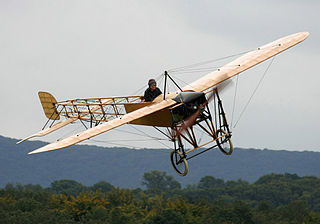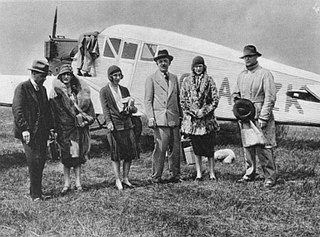
The Air Accidents Investigation Branch (AAIB) investigates civil aircraft accidents and serious incidents within the United Kingdom, its overseas territories and crown dependencies. It is also the Space Accident Investigation Authority (SAIA) for the United Kingdom. The AAIB is a branch of the Department for Transport and is based in the grounds of Farnborough Airport, Hampshire.

This is a list of aviation-related events from 1912:

The Blériot XI is a French aircraft from the pioneer era of aviation. The first example was used by Louis Blériot to make the first flight across the English Channel in a heavier-than-air aircraft, on 25 July 1909. This is one of the most famous accomplishments of the pioneer era of aviation, and not only won Blériot a lasting place in history but also assured the future of his aircraft manufacturing business. The event caused a major reappraisal of the importance of aviation; the English newspaper The Daily Express led its story of the flight with the headline "Britain is no longer an Island".

Isidore Auguste Marie Louis Paulhan, was a French aviator. He is known for winning the first Daily Mail aviation prize for the first flight between London and Manchester in 1910.

Blériot Aéronautique was a French aircraft manufacturer founded by Louis Blériot. It also made a few motorcycles between 1921 and 1922 and cyclecars during the 1920s.

Bathurst Airport is an airport serving Bathurst, New South Wales, Australia.

The Beagle B.206 is a 1960s British seven-seat twin-piston engined liaison and communication aircraft built by Beagle Aircraft Limited at Shoreham Airport and Rearsby Aerodrome.
The Flanders F.2 was a 1910s British experimental single-seat monoplane aircraft designed and built by Richard Leonard Howard-Flanders and later converted to a two-seater as the Flanders F.3.
Lieutenant Wilfred Parke RN (1889–1912) was a British aviator who was the first pilot to make an observed recovery from a spin.
Lympne Airport, was a military and later civil airfield, at Lympne, Kent, United Kingdom, which operated from 1916 to 1984. During the First World War RFC Lympne was originally an acceptance point for aircraft being delivered to, and returning from, France but was later designated as a First Class Landing Ground, RAF Lympne. It became a civil airfield in 1919 and saw the operation of early air mail services after the 1918 armistice. It was one of the first four airfields in the United Kingdom with customs facilities.

Cecil Howard Pixton was a British aeronautical engineer, test pilot and air racing pilot who was most famous for winning the 1914 Schneider Trophy seaplane race.

The Meopham Air Disaster occurred on 21 July 1930 when a Junkers F.13ge flying from Le Touquet to Croydon with two crew and four passengers crashed near Meopham, Kent with the loss of all on board. The report of the inquiry into the accident was made public, the first time in the United Kingdom that an accident report was published.
Lieutenant Desmond Arthur (1884–1913) was an Irish aviator in No. 2 Squadron of the Royal Flying Corps. Following his death in Scotland's first fatal aircraft accident; a government inquiry was launched to investigate the circumstances surrounding the crash. The first inquiry found him responsible, but a later investigation exonerated Arthur. Arthur's ghost is claimed to haunt the RAF Montrose airfield in Montrose, Angus, Scotland, and paranormal enthusiasts consider it to be one of the most well-known ghost stories of the First World War. Desmond Arthur was the first Irishman to be killed in an aircraft accident.

The ASL Valkyrie was a canard pusher configuration aircraft designed by the Aeronautical Syndicate Ltd in 1910. Examples were widely flown during 1911 and were used for instructional purposes at the ASL flying school, which was the first occupant of Hendon Aerodrome in London.

In 1911 the British War Office announced their first Military Aeroplane Competition for aircraft to meet the requirements of the Air Battalion Royal Engineers. The formal requirements were published in December 1911. By the time the trials were held in August 1912, the Air Battalion had become the Military wing of the Royal Flying Corps (RFC). It was held at Larkhill on Salisbury Plain, and the competition was won by S. F. Cody with his Cody V biplane.
Graham Gilmour was a British pioneer aviator, known for his impromptu public displays of flying. He was killed on 17 February 1912 when his Martin-Handasyde monoplane suffered a structural failure and crashed in the Old Deer Park in Richmond, London.

The pioneer era of aviation was the period of aviation history between the first successful powered flight, generally accepted to have been made by the Wright Brothers on 17 December 1903, and the outbreak of the First World War in August 1914.

Joyce Green, at Long Reach, near Dartford, was one of the first Royal Flying Corps (RFC) airfields. It was established in 1911 by Vickers Limited who used it as an airfield and testing ground. At the outbreak of World War I in 1914, the RFC followed and established a base. Subject to frequent flooding and a reputation as being unsuitable and too dangerous for training, it was eventually replaced by a more suitable site at RAF Biggin Hill.













